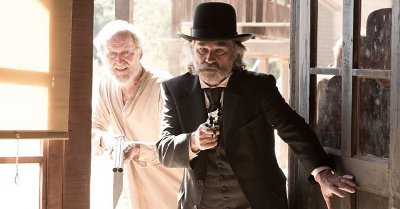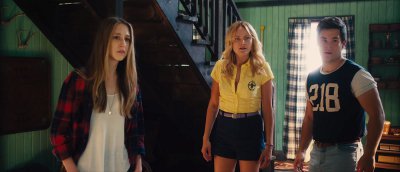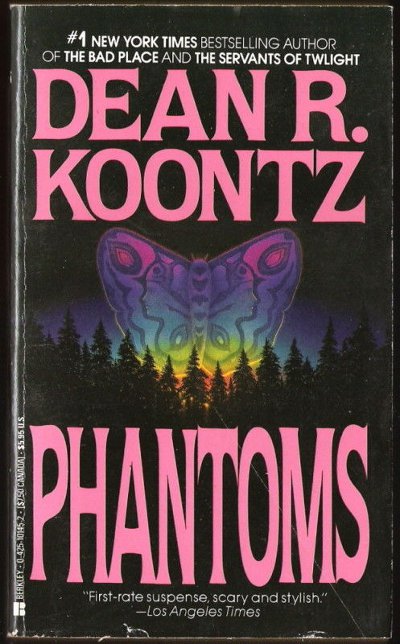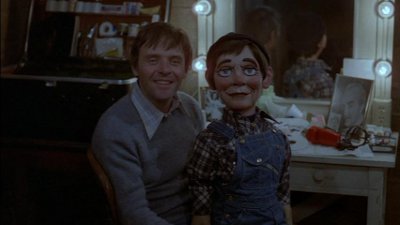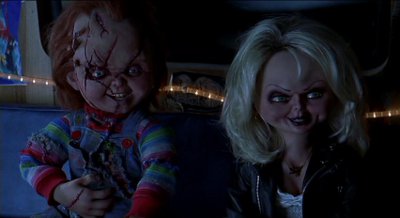It appears that Dennis Cozzalio of the Sergio Leone and the Infield Fly Rule blog is back on track, having posted two whole movie quizes within a couple weeks of each other. Given the Six Weeks of Halloween horror movie marathon, I’m going to tackle Professor Abraham Setrackian’s horror themed quiz first (I will do the other one after 6WH). Previous installments answering questions from Professor Hubert Farnsworth, David Huxley, Professor Fate, Professor Russell Johnson, Dr. Smith, Professor Peabody, Professor Severus Snape, Professor Ed Avery, Dr. Anton Phibes, Sister Clodagh, Professor Arthur Chipping, Miss Jean Brodie, Professor Larry Gopnick, Professor Dewey Finn, and Ms. Elizabeth Halsey are also available.
1) Edwige Fenech or Barbara Bouchet?
When I was coming up with “Obscure Horror Auteurs” for this year’s Six Weeks of Halloween horror movie marathon, one of the filmmakers I looked into was Sergio Martino. I may still get to him at some point, but I ultimately decided against it because many of his movies just aren’t conveniently available. However, like a lot of giallos, they do have worderfully catchy names, such as the Edwige Fenech led Your Vice Is a Locked Room and Only I Have the Key (alas, seems hard to find). She has lots of other nifty titles to her filmography too, including some that I’ve even seen. Barbara Bouchet, on the other hand, is a little less known to me, and to be honest, Don’t Torture a Duckling is not really my favorite giallo. So Edwige Fenech it is!
2) The horror movie you will stand up for when no one else will
I feel like there are whole sub-genres I stick up for when few others will (don’t forget, this is the internet, someone somewhere is standing up for nearly everything), in particular, the slasher film is treasured by us here at Kaedrin. It’s horror movie comfort food, like a comfy sweater on a cold autumn day. There are many specific films I could list here, but I’ll go with one of my favorites, Jason Lives: Friday the 13th Part VI.
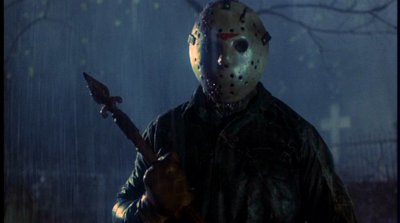
Jason Lives!
Other contending slashers that few stand up for: My Bloody Valentine, The Prowler, and April Fool’s Day. Another much lamented sub-genre: Torture Porn. It’s not really my thing, but I think people in the future will view those movies the same way we view slashers today. Finally, to take this question in another direction, one movie I’ll stand up for when no one else will…. because they don’t even know about it… is Detention. It’s a divisive film to start with, but no one’s heard of it, and I love it to death.
3) Your favorite horror novel
It’s cliche to say Stephen King’s The Shining, so I think I’m going to settle for Dean Koontz’s Phantoms, followed closely by Midnight. The major caveat here is that I haven’t read any of these books in, like, 20 years, and my teenaged self didn’t have quite as refined of a taste. That being said, Phantoms is the one I’d be most interested in revisiting.
Also of note, F. Paul Wilson’s The Keep, another one I haven’t read in a long time but which I remember fondly. I… should really read more horror these days. Special caveat here, if we were to include short stories, that opens things up considerably, and would probably involve some sort of Clive Barker or Richard Matheson story.
4) Lionel Atwill or George Zucco?
This one goes to Lionel Atwill by default, since I’ve actually seen Captain Blood, but I can’t say as though he made a major impression.
5) Name a horror film which you feel either goes “too far” or, conversely, might have been better had been bolder
Martyrs is the film that leaps to mind, but then, going too far is kinda the point, I guess. It’s one of those movies that prompts you to question what the hell you’re doing watching such depravity, but you also have to admire its dedication and unflinching exploration of its concept.
6) Let the Right One In or Let Me In?
Hands down, Let the Right One In. Nothing inherently wrong with Let Me In, except the fact that it doesn’t really do enough to justify remaking the original movie.
7) Favorite horror film released by American International Pictures
I will eschew the typical Poe/Corman answers and jump to The Abominable Dr. Phibes, which has always fascinated me because of its influence within the genre.
8) Veronica Carlson or Barbara Shelley
I’m not really the biggest fan of Hammer Horror, but I tended to appreciate the Frankenstein films moreso than the Dracula ones, so Veronica Carlson it is!
9) Name the pinnacle of slasher movie kills, based on either gore quotient, level of cleverness or shock value
Fantastic Fest is this great film festival that focuses on genre fare, and they have this one event called 100 best kills where they show clips of the best kills, as curated by a couple of weird dudes who love this stuff. They have this great A/V equipment that allows them to speed up or slow down and easily replay the kills so you can see them in all their glory. It takes like 3 hours. So to answer this question, well, I’m not going to spend that long… but I probably could. Here are some great examples. First up is an obvious one, Jack in Friday the 13th, blatantly stolen from Mario Bava’s A Bay of Blood (aka Twitch of the Death Nerve), but the added starpower of Kevin Bacon always keeps it relevant. Jason has a lot of great kills, actually, including a slew of other Bava-inspired ripoffs in the early films, but also the Sleeping Bag kill in Friday the 13th Part VII: The New Blood (with a wonderful callback in Jason X), when Jason boxes with that guy in Friday the 13th Part VIII: Jason Takes Manhattan and knocks his head off, death by liquid nitrogen in Jason X, the list goes on. Also of note, from Jason’s rival Freddy Kreuger, two all time classics in A Nightmare on Elm Street, including Tina’s death (interesting because she’s dying in her dream, but we’re watching her being thrown around like a rag doll out here in the “real” world) and Johnny Depp’s death (for its improbable amount of blood; they really got a lot of use out of that rotating room rig thing). But you already know all those, right? What are the more obscure ones? Tom Savini worked on two movies with lots of great stuff, The Prowler (the pitchfork being particularly memorable) and Maniac (though it should be noted that Maniac’s most famous kill involves a shotgun, a decidedly non-slasher implement of terror). You’ve got to love the raft scene in The Burning (I particularly love the way he poses with those garden sheers, despite how pointless that pose would be in that situation) and oh, that scene where the girl accidentally skateboards into a mirror in Pieces. I should probably stop right now before I really disturb everyone, but you know what’s funny? I’m using a pretty restrictive definition of “Slasher” here, not including neo-slashers or proto-slashers (I mean, yes, of course I want to talk about the trombone with a knife attached in The Town That Dreaded Sundown, but you have to draw the line somewhere, right. But it’s a trombone with a knife attached!)
10) Dracula (1931; Tod Browning) or Dracula (1931; George Melford)?
Alas, I have not seen the Spanish-language version, so I must take a mulligan here.
11) Name a movie which may not strictly be thought of as a horror film which you think qualifies for inclusion in the category
In the interest of not always falling back on my favorite movies (but The Terminator fits here!), I will go with Coherence. It certainly doesn’t start out that way, but as the implications of what’s happening start to emerge, it gets pretty horrific.
12) The last horror movie you saw in a theater? On home video?
Last one in the theater was The Visit, M. Night Shyamalan’s attempt to clime out of the decade long hole he’s been digging. It has its moments, and I have to appreciate the goofiness of the premise, but it also has some cringeworthy stuff (I thought we got over the whole isn’t it funny when white people try to freestyle rap thing, like, 20 years ago, and there are 3 goddamn scenes in this movie where a kid does horrible rap). Not a return to the promise that started his career, but at least a movie worth watching, so he’s on the right trajectory.
On home video, well, I’ve been chronicling them pretty thoroughly of late. Last week was Dolls and Dummies, before that was Comic Horror week, then a mini-Henenlotter marathon, and also some Larry Cohen and Mario Bava (the last three there part of a series of “Obscure Horror Auteurs”). It’s been fun so far, and we’re covering some new(ish) releases this weekend (stay tuned!)
13) Can you think of a horror movie that works better as a home video experience than as a theatrical one?
It is surprising how many horror movies are better, or at least different at home. Horror movies are almost always scarier at home (assuming you’re playing along), but there are some that work better with audience participation. Still, I feel like most of the classics benefit from a quiet, dark home viewing. The Exorcist comes to mind as something you don’t really want to hear other people reacting to (there are probably a million others, but I’ll stick with that one).
14) Brad Dourif or Robert Englund?
Robert Englund, full stop. I mean, Freddy Kreuger is almost as much his creation as Wes Craven’s, and even beyond that, Englund has established himself as a sorta grand old man of the genre, instantly classing up whatever film he’s in (and he’s not above appearing in trashy independent fare either, thus giving those films a nice little boost).
15) At what moment did you realize you were a horror fan? Or what caused you to realize that you weren’t?
When I was younger, I was absolutely terrified of horror movies and hated even the thought of watching them. Then I went over a friend’s house on Halloween to go trick ‘r treating and when we got back, he put on Carpenter’s Halloween. Nothing like good old peer pressure to force you to watch something new, but lo and behold, I fell in love with the horror genre during that viewing. Since then, I’ve been mildly voracious when it comes to horror.
16) The Thing with Two Heads or The Incredible Two-Headed Transplant?
I have, sadly, not seen either of these movies, but at least the former has been on my radar (while I’ve never heard of the latter).
17) Favorite giallo or giallo moment
Blood and Black Lace is, by far, my favorite giallo. My favorite scene is probably the one with the handbag at the fashion show. Bava makes great use of the frame in that sequence, and builds tension like the master he is.

Blood and Black Lace
18) Name a horror remake, either a character or an entire film, that you prefer over its original or more iconic incarnation. (Example: Frank Langella’s Dracula/Dracula > Christopher Lee’s Dracula/Dracula)
While recent remakes don’t have the greatest reputation, there are a surprising number of remakes that are far superior to the original. Two examples from the 80s immediately jump to mind: The Fly and The Thing. A few weeks ago, The Canon podcast pit these two against each other, claiming that only one could make it into the canon of great films. This seems like conclusive evidence that this “canon” that they are building is nigh worthless, but it’s a fun episode nonetheless. However, since this is my blog, I don’t feel the need to choose one over the other. They’re both great and you can’t make me choose.
19) Your favorite director of horror films
An impossible task, so I’m going to have to narrow the definition of horror here, such that it excludes some obvious greats like Alfred Hitchcock (who, to be fair, was more of a thriller/suspense director than straight up horror). It’s still tough though. John Carpenter has two bonafide classics that are among my favorite movies of all time (Halloween and The Thing), but a lot of his other movies skirt away from horror. Wes Craven has several classics to his name and a more consistently horror genre filmography, but only A Nightmare on Elm Street rises to Halloween/Thing levels in terms of my tastes (though clearly The Last House on the Left and Scream are influential). I’m having a hard time choosing between them, so I’ll just leave it at that. Other notables: David Cronenberg, Mario Bava, Don Coscarelli, and plenty of others. I was actually trying to think of someone more modern, but there is not a huge amount to choose from. James Wan definitely heads that list, Adam Green, Ti West, and Adam Wingard all show promise as well. It’s hard to tell these days, though, since so many horror directors move on to other genres rather than get pigeonholed into horror (even Wan has apparently moved on, directing Fast & Furious movies and the like)…
20) Caroline Munro or Stephanie Beacham?
Caroline Munro is actually a name I recognize and look forward to seeing in stuff, including some of my favorite bad movies, like Slaughter High and Maniac, so let’s go for it.
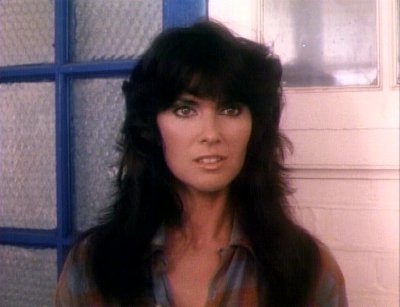
Caroline Munro
21) Best horror moment created specifically for TV
This is a bit of a broad question, so I’ll just go with the first thing that came to mind, which was The X-Files: Home (Season 4, episode 2). I’ve written about this before, so I won’t belabor the point, but it’s an intensely disturbing episode that pretty much outclasses even the films in its sub-genre.
22) The Stephen King adaptation that works better as a movie than a book
The problem here is that the clearest answer is The Shawshank Redemption, which is not a horror story. Plus, it’s not like I’ve read all of King’s books… Looking through the list, though, a couple possibilities include Misery and maybe The Mist. Special mention to Kubrick’s The Shining, which isn’t really better than the book, but which is different enough that it carves out its own identity, allowing both novel and movie to stand as classics. That’s enough of an accomplishment to warrant a mention here.
23) Name the horror movie you most want to see but to this point never have
There are a bunch of silent films that I’d like to catch up with sometime, one of which is The Phantom Carriage. Others include Faust and The Golem. I smell a theme for one week during next year’s Six Weeks of Halloween. In the meantime, I’ll also mention the upcoming film I’ve not seen yet but really want to, Bone Tomahawk. See you on Friday.
24) Andre Morell or Laurence Naismith?
Laurence Naismith, mostly because I can actually recognize him as having been in horror movies I’ve seen…
25) Second-favorite horror film made in the 1980s
Oy, I’ve already told you, I will not choose between The Fly and The Thing, but the answer is probably one of those. Or A Nightmare on Elm Street. Or Evil Dead II. Or… you know, I’ll just stop now before my head explodes, a la Tom Savini.
26) Tell us about your favorite TV horror host and the program showcasing horror classics over which he/she presided/presides
The obvious choice is Elvira, but to be perfectly honest, I don’t have any specific memories about horror movies when it comes to her (I have memories of, um, other things). So I will go with Joe Bob Briggs because he sticks out in my mind the most. In part, this is because I kinda hated him the first time I saw him, but repeated late night horror viewings hosted by Briggs ended up being fun, and I warmed to the guy, who clearly has a lot of love for the genre, knows his stuff, and doesn’t take himself too seriously. Also worth checking out: Zack’s podcast episode on the subject.
